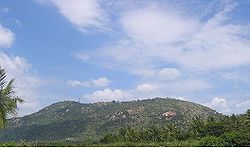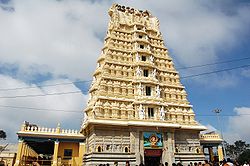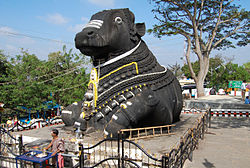- Chamundi hills
-
The Chamundi Hills are located in India, close to the palace city of Mysore. The hills' average elevation is 1,000 meters.
According to legend, the demon Mahishasura, king of the area that is currently Mysore, was killed by the Goddess Chamundeswari (also Chamundi) after a fierce battle. The hills are named after the goddess, and a temple honors her in the hills. The temple has a beautiful idol of the goddess.
The temple has always been patronised by the rulers of Mysore. In earlier days, the Maharajas of Mysore would ride the ceremonial Dasara elephant during the annual Dasara festival; since the seventies, the idol of Goddess Chamundi is taken on an elephant.
A panoramic view of the city is seen from the top of the hills. Among other landmarks, you can see the race course, the Lalitha Mahal palace, Mysore Palace, Karanji and Kukkarahalli lakes.
Chamundi's main hill features a long stone stairway leading to the top of the hill. There are 1,180 steps in all, with the first 600 steps being steeper than those higher up. En route to the top, the steps pass the large statue of Nandi the bull; the statue is about 16 feet high and 25 feet in length. Nandi is the vahana (vehicle) of Lord Shiva. Local monarch Dodda Devaraja Wodeyar directed the steps' creation in 1664[citation needed] and the installation of the statue of Nandi.
There are regular buses to the Chamundi Hills from Mysore's central bus stand.
The top of the hill has a few attractions - the Mahishasura Statue, the Chamundeswari Temple, and a few other temples nearby. The Rajendra Vilas palace used to be a popular hotel earlier, but is now closed to the public. The palace is now being redone and provides a panoramic view of Chamundi Hill, Chamundi Temple and the city of Mysore.
The main Chamundi Hill is about three kilometers east of Mysore and there is a 12 km road leading to the top of the hill. The height of the hill is about 3489 feet above the sea level.
There are two ancient temples on the hill, the Mahabaleshvara and the Chamundeshvari. It is a place of pilgrimage.
According to mythology, this rocky hill was known as Mahabalachala and the Mahabaleshvara temple here is an older one.
The hill takes its name from the goddess Chamundeshwari. It was the family deity of the royal family. This temple was renovated and the beautiful tall tower was built during the time of Krishnaraja Wodeyar III in 1827. The temple is a fine quadrangular structure. This goddess is also called Mahishasura Mardini. The car festival and teppotsava held on the hill attracts a number of devotees.
A statue of Mahishasura with a sword in his right hand and cobra in the left is an attraction here worth seeing.
The Chamundi Hills are near Rajendra Vilas, formerly the summer palace of the former royal family, now a hotel. (Source: Karnataka State Gazetteer 1983)
Climbing Chamundi Hills
Climbing the steps of Chamundi Hills is a popular way of keeping fit among the locals in Mysore.[citation needed] The main set of a thousand steps takes anywhere between 12 to 60 minutes to climb, depending on an individual's fitness levels.
Some individuals climb only till the Nandi statue, which is about 700 steps, then run on the downhill road to the other side of Chamundi Hills for about 2 kilometers, and climb another set of 600 steps to the top. This set of steps at the back of the hill is less used and provides a different challenge for climbers seeking exercise.
Groups of youngsters also tend to trek through the jungle and thickets of the Chamundi Hill slopes to the top. This has reduced in recent years due to stories of leopards residing on the jungle slopes. Sometimes leopards have been sighted near the roads during late evenings leading to the top and have been photographed, providing a sense of additional thrill to people who seek adventure walking up the slopes.[citation needed]
See also
External links
Categories:- Mysore
- Visitor attractions in Mysore
- Hills of Karnataka
Wikimedia Foundation. 2010.




